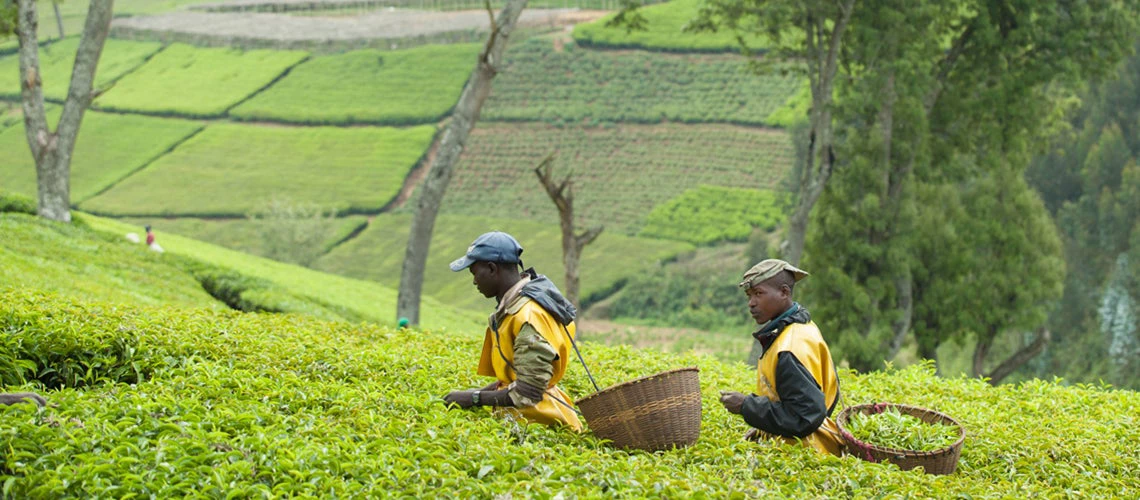 Two workers harvesting tea leaves from a lush green field in Kitabi, Rwanda. Photo: A'Melody Lee/World Bank
Two workers harvesting tea leaves from a lush green field in Kitabi, Rwanda. Photo: A'Melody Lee/World Bank
Nature, which includes biodiversity and services provided by healthy ecosystems, is at the heart of critical development challenges like health, jobs, poverty, inequality, climate change, food security, and fragility. And yet nature is in decline, despite being the most precious asset that many countries have to tackle climate change, end poverty, and ensure sustainability. Nature loss impacts the poorest countries and communities the most.
These challenges cannot be effectively addressed unless we bring nature into the center of economic decision making. One effective approach is by assigning monetary values to nature’s direct and indirect contributions to economies and human wellbeing through what’s known as “natural capital accounting” to establish the economic case for protecting nature.
Understanding the Value of Nature
Natural capital accounting and policy analysis allows us to recognize and value the goods and services provided by nature. By accounting for the contribution of natural assets in monetary values, we can better understand their importance to people and economies. For example, the World Bank estimates that the collapse of select ecosystem services that nature provides for free – such as wild pollination, marine fisheries and timber from native forests – could lead to a global GDP decline of $2.7 trillion annually by 2030. This decline will be felt in agriculture, fisheries, timber production, and climate impacts around the world. Proper valuation of the priced and non-priced benefits to humans from natural assets is key to ensure that economic policies and investment decisions will take the benefits from natural assets into account. Valuation and nature-aware policy analysis allows timely adjustments to protect and conserve nature that is essential for people and economies to thrive.
"The World Bank estimates that the collapse of select ecosystem services that nature provides for free – such as wild pollination, marine fisheries and timber from native forests – could lead to a global GDP decline of $2.7 trillion annually by 2030. "
Guiding Policy Decisions
Ambitious programs and policies, such as subsidy reform, expansion of domestic and global forest-carbon payment schemes, and investment in agricultural research and development, are crucial for stopping and reversing nature loss. The landmark Global Biodiversity Framework agreed by countries around the world in 2022, sets targets for such programs, emphasizing the need for effective policies. Natural capital accounting, coupled with the UN System of Environmental Economic Accounts – Ecosystem Accounting (SEEA-EA) framework, provides essential data to assess policies and investments. Investments in ecosystem services should align with climate change mitigation and adaptation efforts, strengthening the case for action on both. When available, evidence on how nature is changing in a given location helps policymakers identify the right strategies.
Designing Effective Measures
Natural capital accounting offers critical data for devising investments, regulations, and monitoring systems that help address the drivers of nature loss – such as changes in land and sea use, overexploitation, climate change, pollution, and invasive species. Economic instruments, like repurposing subsidies and implementing payments for ecosystem services, can be more precisely targeted using detailed spatial information from natural capital accounts.
Mobilizing Finance for Nature
Implementing biodiversity programs requires substantial financial resources. The Global Biodiversity Framework estimates that $200 billion needs to be raised by 2030 to finance goals “to halt and reverse biodiversity loss to put nature on a path to recovery for the benefit of people”. While most biodiversity finance comes from public sources, it is not enough to meet the growing needs. Sustainability-linked bonds and biodiversity credits offer opportunities for private sector involvement. However, the market for biodiversity credits and nature-linked carbon credits from REDD+ (Reducing Emissions from Deforestation and Forest Degradation) is still relatively small. Developing high-integrity biodiversity credits and expanding the use of sustainability-linked bonds require both accurate data and evidence and the common metrics to measure changes on the extent and condition of affected ecosystems.
Natural capital accounting plays a vital role in mainstreaming nature into economic decision-making. It can serve as an input for nature- and climate-aware economic policy analysis for informing biodiversity policies and driving effective conservation measures. Placing real values on the diverse benefits of nature (including non-priced goods and services) to people and economies helps policymakers make informed decisions and prioritize actions to meet biodiversity targets. Furthermore, it facilitates the mobilization of finance from both public and private sectors. Understanding nature related risks, impacts and opportunities for businesses could help identify policy options to attract and enable private investment for biodiversity.
Embracing natural capital accounting is therefore essential for embedding nature into economic planning and decision-making. Doing this will help to safeguard our planet's natural assets and secure a more livable planet and sustainable future for all.




Join the Conversation